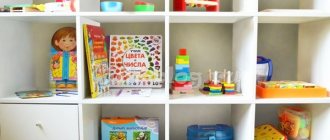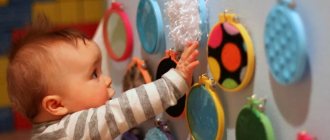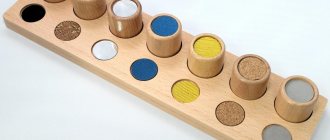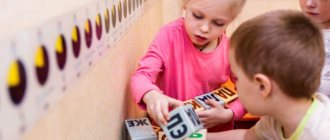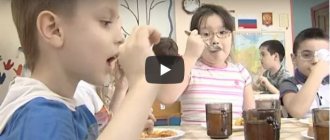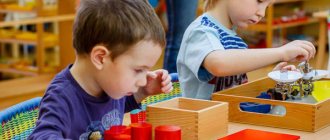The beginning of the twentieth century literally divided the history of mankind into before and after, because life underwent incredible changes and required new moral guidelines, approaches to education and upbringing, and the organization of work and leisure. It was a period of bold experiments and amazing discoveries. Despite all the social upheavals, people of the twentieth century became freer and more progressive, which means that upbringing and education had to change a lot, because kids had to grow up in a completely new world.
The observations and innovations of the Italian doctor Maria Montessori became a real breakthrough in pedagogy, since her approach simultaneously had both a good theoretical basis and brilliant results in practice. In this article we will try to highlight all the main features of Montessori education and discuss for which children classes using the M. Montessori method are best suited.
A little history
Maria Montessori (Italian doctor, anthropologist, teacher) is the creator of a unique education method that became popular in the first half of the 20th century. Maria began her medical career as a physician’s assistant, and while working in an institution for children with disabilities (a psychiatric hospital), she became interested in methods of treating such children. Montessori came to the conclusion that their intellectual problems were partly not only medical, but also pedagogical.
Montessori saw how lonely these children were, no one worked with them, they didn’t even have toys. And then she began to bring the children the simplest objects: scraps, boxes, beads. And the kids seemed to come to life.
Maria Montessori developed a unique method of education, which she initially used in working with children with disabilities
Subsequently, Maria took the position of director of the Orthophrenic Institute, specializing in training teachers to work with sick children. There was a school at the institute where Montessori taught children herself. The result was obvious: many students passed the exam at the secondary school level.
The doctor gradually improved her system of education and training, and then decided to apply it to healthy children - special kindergartens were organized for children 3-7 years old.
Montessori schools have gained great popularity in Europe (especially in Germany, Austria, the Netherlands), the USA, Japan, and North Korea. In Russia, this technique was unavailable for a long time.
People's Commissar of Education A.V. Lunacharsky tried to conduct a series of experiments to introduce Montessori pedagogical principles into the system of Soviet preschool education. However, Stalin did not approve of the innovation: the dissemination of the methodology was banned, and Maria Montessori was labeled a “reactionary teacher.”
This pedagogical system was not remembered in our country until the 90s. It was at this time that the first benefits began to appear. Today, many kindergartens and early childhood development centers in Russia use this unique method, and mothers independently study at home with their children.
Today, many mothers are keen on the Montessori system and use it in home activities with their children.
The logical continuation of this education is primary school, but in Russia, due to strict education standards, this is problematic. There are either rare experimental sites operating on the basis of regular schools, or private schools (“on paper” they are considered ordinary). Although abroad, Montessori training ends at 10–12 years.
A brief description of the essence of Maria Montessori's pedagogy
Briefly, the essence of the Montessori method can be conveyed in one phrase : “Help me do it myself.” The author of the system was deeply convinced that powerful internal potential is hidden in every baby from birth. It is important to create conditions for it to open up, and then a harmonious personality will be formed.
The Montessori system involves education without any coercion. The child should naturally awaken a natural interest in learning. This takes into account his physiological and psychological needs at the moment. The key point will be “what the child wants.”
Basic principles of education
In general, the methodology is based on a number of principles:
- Observation of the child. The task of an adult (parent, educator) is to closely study the baby and understand the features of his inner world.
- Humanism is the complete absence of psychological violence and the use of totalitarian pedagogical methods.
- Freedom, independence. It is unacceptable to suppress a child’s energy; on the contrary, it must be directed in a creative direction.
- Minimum influence from an adult. He simply helps the child understand the subject he has chosen, unobtrusively guides him, and creates the necessary developmental environment.
- Individual approach. The characteristics of the child and the degree of his activity are taken into account.
According to Montessori, the leading motivation for a child is the desire for knowledge, curiosity, and enthusiasm. In this case, education is organically intertwined with learning. The baby develops independence skills and at the same time the emotional world is enriched and self-esteem is formed.
Sensitive periods: at what age what to develop
The Montessori method identifies important sensitive periods. This is the age at which the baby most easily and naturally comprehends certain things:
- Perception of order (0–3 years). Children learn to pick up after themselves, maintain cleanliness, wipe up spilled water, collect spilled cereals, and wash dishes. According to the method, at 4 years old it is already more difficult to introduce the baby to all this.
- Development of actions, movements (1–4 years). Coordination is actively developing and muscles are strengthening. It's time to explore children's playgrounds with their ladders, slides, and swings.
- Sensory development (0–5.5 years). Understanding the world through sounds, smells, tactile perception. Ideas about color, size, shape are formed.
- Perception of small objects (1.5–5.5 years). This is the development of fine motor skills. It is at this time that manipulation with various objects is important: rearranging beads, stringing them on a thread, sorting cereals, beans, peas, putting together puzzles, etc.
- Speech development (0–6 years). Various cards and other visual aids and books help with this. Here the role of the adult is already increasing.
- Development of social skills (2.5–6 years). Again, everything should be learned at ease; it is unacceptable to force a child to say hello or say “thank you.”
When the time has not yet come or, on the contrary, has been missed, it will be difficult or simply uninteresting for the child to master a certain skill.
Video: what is the Montessori method
Comparison of the Montessori method with other early development systems
As you know, the Montessori system is not the only method of early childhood development, so it will be interesting to compare it with other systems.
Table: comparison of the Montessori system with other early development methods
| Author of the method | Distinctive features |
| Zaitsev | The system offers a game form of work. And Montessori classes are not a game, but, in fact, the ordinary life of a child. Here you need a lot more material than tables and a set of cubes. |
| Glenn Doman | Doman training is carried out mainly with the help of cards, there is no impact on the sense of touch. Montessori places great importance on the tactile function. |
| Nikitins | Although classes according to Nikitin are somewhat reminiscent of the Montessori method (the parent is perceived as a senior comrade, and not an inspector), in this system a significant role is assigned to the hardening of children, which is not the case with Montessori. |
| Cecil Lupan | This system is aimed at maximizing active learning in the first year of a child’s life. In Montessori, everything is served in doses, in equal portions at different ages. The child is constantly in the process of learning. |
Pros and cons of Montessori pedagogy
Of course, the Montessori method is unique and leaves few people indifferent. Its supporters highlight the following significant advantages of the pedagogical system:
- The technique can be adapted to different cultures, because it is based on the basic needs of the child.
- The children learn everything with pleasure, because they themselves choose what to do. There is no boredom, no fear of a difficult task imposed by an adult.
- Children who were trained according to Montessori cope better with household responsibilities than others, are more responsible, can properly manage their time, know how to keep themselves busy, while respecting the needs of others.
- Didactic aids and exercises with them contribute to the accelerated development of mental activity, logic and motor skills.
The Montessori method promotes the accelerated development of intelligence and logical thinking
However, the technique also has its opponents. And their criticisms can be summarized in the following theses:
- There are no spontaneous creative games, for example, role-playing games. And this is very important for the development of the child’s imagination, his emotional sphere. The system does not pay enough attention to creative activities (fine arts).
- Predominant intellectual development distorts normal psychology and deprives the child of the carefree joy of childhood. Montessori underestimates the role of play in a child's development and replaces it with useful activities with teaching aids.
- In the pedagogical process, reading fairy tales is ignored. Maria Montessori considered them a departure from reality and replaced them with a realistic description of objects. Hence, the child does not develop the ability to empathize, fantasize, or conduct an internal dialogue with the characters of the work.
- A child who studied at home using this system (and also who attended such a kindergarten) will find it quite difficult in a regular school, where all the students sit at their desks, performing a specific task from the teacher. In addition, such a student has already formed an attitude towards an adult as an assistant, and not as an authority.
- Many children are brought up in families with an authoritarian order and therefore not every mother is able to act as an older comrade or assistant (as the Montessori system assumes).
- The technique is not suitable for all children. This is a bad option for overly mobile, active guys who have problems with perseverance and concentration. In addition, if the child has expressed creative abilities, then they will be unclaimed, since the technique is based on a rational way of understanding the world.
The Montessori method is not suitable for an overly active, active child, since it is aimed at quiet activities that require concentration.
Video: for whom the Montessori method is not suitable (a specialist explains)
Creating a nurturing Montessori environment at home
Since in the Montessori system the primary role is played by the conditions for unlocking the child’s potential (and not the imposition of ready-made templates), the role of the developmental environment increases. In a child’s nursery, it is advisable to highlight several key areas of development:
- Practical activity area. Its task is to instill self-service skills and perform simple household functions. Functional toys are placed here: dishes, cleaning items (preferably real, not toy ones - sponges, rags, brushes, etc.), aids with buttons, snaps, zippers, lacing, etc.
- Zone of sensory development. These are various small objects, puzzles, boxes of cereals, sensory bags, insert molds, sets of geometric shapes of different shapes, sizes, colors, musical instruments, hammers, jars with aromatic substances, scraps of fabrics of different textures, lacing, etc. In general, there are objects for the development of the senses. In general, Montessori paid special attention to the development of touch and fine motor skills, believing that it was precisely precise actions with small objects that improved thinking, speech, memory, and attention.
- Native language zone. Here children learn letters, learn to read, prepare to master writing skills, and develop sound perception. The filling of the zone will be appropriate: cards with rough (velvet paper) letters, syllables and whole words, just figures of letters, their stencils for tracing, semolina with a tray (on which the child will write letters), etc.
- Math zone. Here there are boxes with numbers (cards and three-dimensional figures), signs for mastering the operations of addition, subtraction, multiplication and division, barbells, spindles, Seguin boards, a set of gold beads, etc. Moreover, it is not necessary that the preschooler master all mathematical operations (especially multiplication and division): it all depends on his enthusiasm and individual pace of development.
- Natural science or space zone. Here the child gets acquainted with the world around him (including the universe), learns to classify living and inanimate nature, and learns the relationships and patterns in it. The child will have the opportunity to conduct real experiments: for example, make sure that a tree burns and a stone sinks in water, build a mini-volcano that will erupt, etc. In the zone there are various cards with images of plants, animals, posters on the human structure, a globe , world maps, models of planets of the solar system, etc., materials for experiments.
- Area of development of gross motor skills, or motor. It is located away from other areas and contains sports equipment.
It is clear that at home (especially if the children's room is small) it is often unrealistic to arrange all these areas, but try to at least allocate separate shelves, for example, in a rack for each group of benefits.
Photo gallery: rooms for small children, decorated according to Montessori conditions
The nursery has a wonderful corner for developing gross motor skills.
Even a blanket on the bed provides an opportunity for sensory development
Such a wardrobe from an early age teaches the child to be independent and develop self-care skills.
The parents' task is to periodically change the contents of the upper and lower shelves so that the child can choose his own study aids
Education according to the M. Montessori systemmaterial on the topic
Pedagogical system M. Montessori
Maria Montessori (08/31/1870 - 05/06/1952) was the first woman doctor in Italy, scientist, teacher and psychologist, who first began to use her system with mentally retarded preschool children. The system was used in the Children's Home, which she opened on January 6, 1907 in Rome. Observing children, Maria, through trial and error, gradually developed sensory materials that arouse and stimulate children's interest in knowledge. Since 1909, Montessori pedagogy and its books began to spread in many countries around the world. In 1913, the system became known in Russia. And since 1914, Montessori kindergartens were opened in many Russian cities. But 10 years later the Bolsheviks closed these kindergartens. Only in 1992 did the Montessori system return to Russia.
The main idea of this pedagogical system: maximum disclosure of the natural potential of each child, support of his individuality and uniqueness, development of independence and independence, acquisition of skills of social interaction with children of different ages and at the same time comprehensive harmonious development in accordance with the natural rhythm of the child himself. This pedagogical approach allows you to preserve the physical and psychological health of the child during the learning process and give him maximum knowledge.
Montessori pedagogy is a system of child self-development. The child is given the opportunity to move independently and develop independently; this happens spontaneously, but if in some cases he needs the help of an adult, he receives it. All adults do is organize an environment for the child in which he already moves on his own. In the unique system of self-education and self-development of young children, the main focus is on nurturing independence, developing senses (vision, hearing, smell, taste, etc.) and fine motor skills. There are no uniform requirements and training programs in this system. Each child works at his own pace and does only what interests him.
Montessori's philosophical views are based on the "Cosmic Theory", which reflects an understanding of the nature of the child and the laws of its development.
“All... living beings, in the process of feeding or searching for food, perform a “cosmic” task, which helps to preserve nature in a harmonious state of purity.”
The main principle of the Montessori system is “Help me do it myself!” This means that an adult must understand what interests the child at the moment, create an optimal environment for him to study and unobtrusively teach him how to use this environment. Thus, the adult helps each child find his own individual path of development and reveal his natural abilities. Everything and everyone in the Montessori system stimulates the child to self-education, self-education, self-development of the potential inherent in him.
The main components of the Montessori system, allowing for the implementation of an individual path of child development: adults, developmental environment, didactic material.
The main task of an adult in relation to a child directly in the process of classes is not to interfere with his mastering the world around him, not to transfer his knowledge, but to help collect, analyze and systematize his own.
The essence of education according to M. Montessori is to promote the psychophysical development of the child (“Help for life from birth”). For Montessori, the spiritual development of a person was closely connected with his psychophysical development; she constantly emphasized the most important role of the development of perception and sense organs (sensitivity), the motor sphere for the development of intelligence, thinking abilities, and general development in general.
Goals and objectives of education
The goal is to achieve world harmony, build a universal society.
The main task of an adult is to create an environment suitable for the free and full development of the child, as well as for the possibility of choice and independent activity.
According to Maria Montessori, the process of development of a child's personality is divided into four stages:
- first stage of childhood (0-6 years);
- second stage of childhood (6-12 years);
- youth (12-18 years old);
- growing up (18-24 years).
Each of these stages represents a distinct independent segment of development.
In the period from 0 to 6 years, the child’s cognitive activity is aimed at forming a sensory image of the world around him through the instinctive development of the senses: smell, touch, vision, hearing. The goal of education from 0 to 6 years is to optimize the process of natural development, to achieve “normalization.” The tasks of promoting development are solved: concentration of attention, voluntary movements, sensory sphere, speech, writing and reading skills, elementary mathematical concepts, ideas about the world around us, the ability to make choices, make decisions, and learn independently.
From 6 to 12 years old, the child takes on the position of a researcher in relation to the world around him. The purpose of education is the formation of “universal consciousness” and a sense of responsibility towards humanity. At this stage, the following tasks are solved: 1) to promote the development of systems thinking and environmental thinking; 2) show the place of the Earth and man in Space; 3) “sow the seeds” of various sciences as parts of a single whole.
Between the ages of 12 and 18, a teenager is actively looking for his place in society. The purpose of education is to develop the ability to interact effectively with society. Objectives: 1) to promote the personal development of adolescents; 2) provide the opportunity for a full education.
Pedagogical principles of M Montessori:
1) Promotion of natural development (conformity with nature);
2) Interaction with the “prepared environment”;
3)Freedom of choice in a “prepared environment”;
4) Individual activity in learning (motivational, motor, self-control, speech and cognitive activity, activity in the social sphere);
5) Subject matter in teaching.
According to Montessori principles, children are given as much freedom as possible under the supervision of a teacher, which requires a lot of mental stress from her.
The main Montessori method is the “free work” of children in a “prepared environment” while limiting the direct influence of the teacher.
Methods of education in different periods of development:
From 0 to 6 years old, educational methods are used: observation; Giving help; display; offering material with a focus on the zone of proximal development; maintaining order and working atmosphere; individual exercises with the whole group.
From 6 to 12 years old, educational methods are used: observation; assistance in independent study of the material; from general to specific, from whole to detail: presentation of general schemes; awakening and active use of the power of imagination; group classes.
From 12 to 18 years old, educational methods are used: assistance in independent study; assistance in mastering the basics of professions; alternating educational activities with practical work; awakening interest in various types of practical activities and sciences; orientation of students in educational material.
The Montessori child development system is based on the following principles:
- The child is active. The role of the adult directly in the learning event is secondary. He is a helper, not a mentor.
- The child is his own teacher. He has complete freedom of choice and action.
- Children teach children. Since children of different ages study in groups, older children become teachers, while they learn to care for others, and younger children follow the elders.
- Children make their own decisions.
- Classes take place in a specially prepared environment.
- The child needs to be interested, and he will develop himself.
- Full self-development is a consequence of freedom in actions, thinking, and feelings.
- A child becomes himself when we follow the instructions of nature, and do not go against them.
- Respect for children - absence of prohibitions, criticism and instructions.
A child has the right to make mistakes and figure everything out on his own. The development of children according to the Montessori system implies that the child learns, first of all, by playing with objects. The subject of the game can be any thing: a basin, a sieve, a glass, a spoon, a napkin, a sponge, cereal, water, etc. But there are also special classic Montessori materials - the famous Pink Tower, Brown Ladder, insert molds, etc.
Any exercise with Montessori didactic material has two goals: direct and indirect. The first promotes the child’s actual movement (unfastening and fastening buttons, finding identical sounding cylinders), and the second is aimed at the future (development of independence, coordination of movements, refinement of hearing).
Classes in a Montessori group begin with free work. Each didactic material in the group has its own algorithm of work, and if the child took this or that material for the first time, the teacher gives a presentation of the material. The classes also include Circle. This is a gathering place for children where the current situation is discussed. The child retains the right to express himself independently, the “Circle” ends and the children begin a creative task that corresponds to the theme of the “Circle”.
There are certain rules in the group; over time, the older children teach the newly arrived children. Also, one of the main features of the group is the diversity of ages of students. Younger children are drawn to older ones, and they, in turn, protect and help the younger ones, which teaches them tolerance.
In the kindergarten, working according to the Montessori system, there are 18 people in the group of different ages, from 3 to 6 years.
Montessori group lessons include:
- work in a Montessori environment;
- circle of acquaintance with the outside world;
- creative workshop;
- visiting a fairy tale;
- aerobics for kids.
Free work with Montessori materials is individual work in a specially prepared Montessori development environment aimed at the comprehensive development of the child.
The circle is a special form of work in the Montessori method. It includes a greeting - an “emotional” start to work, children greeting their friends and teachers; finger games; nursery rhymes; acquaintance with the outside world, with social reality.
A creative workshop is the use of various techniques in an accessible form: drawing with palms, using foam sponges, a stencil; modeling from plasticine and salt dough, coloring; cutting; gluing, etc. This activity is aimed at developing fine motor skills, creative thinking and aesthetic perception.
Visiting a fairy tale - in class, the teacher shows children a fairy tale, which is aimed at developing speech, understanding and identifying cause-and-effect relationships and patterns.
Aerobics for kids is the organization of physical education and health activities for children: walking, running, outdoor games, elements of aerobics and gymnastics, exercises with a stick and fit ball, dance movements - all this helps children acquire health, beauty, harmony.
To assist the self-development of a child from 3 to 6 years old, educational sections of the “prepared environment” are used, divided into zones:
- Exercise area in everyday life - materials with which the child learns to take care of himself and his things, i.e. what you need in everyday life.
- The sensory education zone is intended for the development and refinement of the perception of the senses, the study of sizes, shapes, etc.
- Mathematical zone - for understanding ordinal counting, numbers, composition of numbers, addition, subtraction, multiplication, division.
- The native language zone is designed to expand vocabulary, familiarize yourself with letters, phonetics, understand the composition of words and their spelling.
- The Space Zone is intended for getting acquainted with the surrounding world and the significance of the role of man in it, for mastering the basics of botany, zoology, anatomy, geography, physics, and astronomy.
Within each section, materials are ordered by degree of difficulty.
Materials developed by M. Montessori for the development of the senses are still produced today. Montessori came up with a “magic bag” (made of fabric), which is widely used in kindergartens, into which they put various small things that children recognize by touch. A huge advantage of the method is the continuity of learning between preschool and school age, the unity of requirements for children in the orphanage and Montessori primary school.
Disadvantages of the M. Montessori system
Like any system, this also has its disadvantages:
1. The system concentrates only on the development of intelligence and practical skills. Exercises and didactic materials are aimed at developing analytical thinking, logic and motor activity.
2.The system does not contain role-playing or active games.
3. Denial of creativity as an obstacle to the mental development of children (while research by psychologists suggests the opposite). It should be noted that the last two disadvantages are compensated by the fact that in Montessori kindergartens they necessarily create ordinary playrooms, and the child does not spend all his time in the kindergarten.
4.After the democratic Montessori system, it is difficult for children to get used to maintaining discipline in ordinary kindergartens and schools.
Commandments of Maria Montessori:
- Never touch a child until he himself contacts you (in some form)
- Never speak badly about a child, either in front of him or without him.
- Concentrate on developing the good in the child, so that in the end there will be less and less room for the bad.
- Be proactive in preparing your environment. Take constant meticulous care of her. Help your child establish constructive interactions with her. Show the place of each developmental material and the correct ways to work with it.
- Be ready to respond to the call of a child who needs you, always listen and respond to the child who turns to you.
- Respect the child who made a mistake and will be able to correct it now or a little later, but immediately firmly stop any incorrect use of the material and any action that threatens the safety of the child himself or other children, or his development.
- Respect the child resting or watching others at work, or thinking about what he has done or is about to do. Never call him or force him to take other active actions.
- Help those who are looking for a job and cannot choose one.
- Be tireless, repeating presentations to the child that he had previously refused, helping the child to master previously unmastered things and overcome imperfections. Do this by filling the world around you with care, restraint and silence, mercy and love. Make your willingness to help obvious to the child who is searching, but invisible to the child who has already found everything.
- Always use your best manners when dealing with your child and offer him the best of you and the best of what you have at your disposal.
Training rules and materials for classes
It is interesting that the most ordinary objects can act as toys using this method: a basin, a strainer, napkins, a spoon, a sponge, etc. Along with them, there are also specially designed Montessori aids: for example, the Pink Tower, the Brown Ladder, insert molds , numerical machines, frames with fasteners, etc.
Along with ordinary objects, the method involves the use of special aids developed by Maria Montessori
In general, didactic materials in the Montessori system arouse keen interest in the child, involve practical activity (rather than abstract explanations from an adult), provide the opportunity for repeated repetition, independent correction of mistakes, and foster independence and independence.
When studying didactic material, you need to teach your child to follow certain rules:
- All manuals and toys are publicly available. But the baby must learn that they cannot be scattered around the room, but must be put in their place.
- The child always chooses the material for the lesson himself.
- An adult should tell the child that they should not switch attention from one manual to another: the exercise should be completed.
A teacher or parent needs to praise the child more often and respect his efforts. This will further stimulate independence and self-confidence.
In general, as far as Montessori home education is concerned, any parents can make their entire home a “developmental environment.” To do this, in addition to purchasing appropriate toys, you need to allow the child to participate in the everyday life of the family: doing all possible cleaning, caring for plants, pets, repairing their toys, and doing handicrafts.
Parents (fans of the Montessori system) can organize a “developmental environment” at home - allow children to participate in cleaning and other household activities
“Help me do it myself.” Principles of the Montessori system
The main idea of learning is freedom, which the baby strives for from birth. Maria believed that if you organize a special environment for a student and allow him to work independently in it, he will become independent, inquisitive and self-confident. The teacher only helps the child’s mind develop and does not impose his own attitudes.
Montessori school day schedule
- 9:00 - 10:00. The guys greet and examine each other, help if necessary (put on an apron, fasten a button). Monitor the cleanliness of the room. They talk about what interesting happened yesterday. Conducting a religion lesson.
- 10:00 − 11:00. Exercises (tasks aimed at developing mental abilities) with breaks for rest.
- 11:00 - 11:30. Light gymnastic exercises, performed as smoothly as possible. Special attention to correct posture and walking. Exercises to develop attention. Children arrange things beautifully and neatly in the room.
- 11:30 - 12:00. Lunch, short prayer.
- 12:00 - 13:00. Games in the classroom (the children decide for themselves what and how to play).
- 13:00 - 14:00. Outdoor games. Older children do hands-on exercises and cleaning. Then they again examine each other’s appearance (clean hands, neat clothes). They talk freely.
- 14:00 - 15:00. Homemade crafts (sculpting, weaving, assembling/disassembling, drawing). 8. 15:00 - 16:00. Everyone does gymnastics together, preferably outside. They think about their goals and plan step by step how to implement their plans. Take care of plants and animals.
The teacher noted bursts of attentiveness in children aged 3-6 years. At the same time, they effortlessly concentrated on one type of activity.
If the child was allowed to choose what to do, he preferred to take a textbook or make something. And toys and goodies that were freely available were ignored.
Continuing her observations, Maria discovered spontaneous manifestations of self-discipline and a thirst for knowledge. The kids suddenly began to lay out their toys, finding their place for each thing. Or they started studying the material with pleasure and solving problems. This means that when choosing an activity, a child is driven by natural instinct. That’s why he gets down to business with such enthusiasm and does the job efficiently.
Maria Montessori's exercises are based on the fact that at different ages the child is adapted to a specific activity.
Young children perceive information better by hearing, so you can study the pronunciation of foreign words with them. At 5 years old, the child is already ready for grammar, since he concentrates well on writing. Another period - from 3 to 6 years - includes children's tendency to order. During this time, it is necessary to instill in the child self-care skills. He dresses himself, cleans his clothes, wipes the dust, sweeps the floor, waters the flowers.
Principles of the method
- Independence. Each child chooses activities from the proposed list.
- Reasonable freedom. Students move around the classroom without restrictions, move chairs and tables if desired, and organize their personal space.
- "We teach through discovery." Children gain knowledge through practice rather than listening to teacher lectures.
- "The Absorbent Mind" Until the age of 6, a child unconsciously absorbs everything that surrounds him: from culture and habits to life attitudes. Therefore, special attention is paid to preparing the environment: the room is spacious and bright, there is access to water, and there are flowers that the student will care for. Fragile things are placed on the shelves so that he learns to treat them with care. All educational materials are located at the child's eye level, calling him to action (learning).
- Developmental exercises.
- Continuous work cycles (average 3 hours).
- Classes are taught by a qualified Montessori teacher.
Tips for organizing home activities with children of different ages
It is advisable to divide recommendations for parents on homework by age.
Up to a year
From the age of 5 months, a mother can use busy boards, because these developmental aids were invented by Maria Montessori (originally they were wooden, but today they have been adapted into soft rugs and books). You can also use tactile exercises with pads filled with cereals, pebbles, and foam. Let the baby just touch them.
Interestingly, the idea of creating a busy board (developmental board) belongs to Maria Montessori
Another type of activity is holding out objects to the toddler and transferring them from one child’s hand to another.
Video: Montessori educational toys for babies
From one year of age to 3 years
The range of exercises is expanding, the following options are being added:
- Games with water. The baby catches small toys and pebbles from a bowl of water (with his hands or a net), pours water from a watering can, and pours liquid from one container to another.
After one year, you can already offer your child manipulations with water.
- Stringing objects onto a support (based on the pyramid principle).
- Games with a spoon (catching objects with it).
- Exercises with clothespins (fastening them to a rope or fabric).
- Fasteners, lacing.
- Sorting items poured into one container (buttons, pasta, small toys, etc.).
After a year, you can introduce exercises for sorting cereals and small items
- Drawing on sand with a stick, brush, etc.
- Feeding a plastic toy (through a cut-out mouth).
- Modeling from plasticine (rolling balls, sausages).
Video: Montessori water games
For ages 2–5 years
Wooden toys (geometric figures, etc.), puzzles, and didactic games to get acquainted with the outside world are already being actively used. The study of numbers and letters begins.
In the period from 2 to 5 years, the study of numbers and letters begins
In addition, you should actively involve the child in performing household chores: helping with washing, cleaning, cooking (for example, kneading dough, arranging fruits by color).
After 5 years
At this age, perseverance develops, and the previously mastered skills of self-care and house cleaning become more complex. Math and reading are being actively taught. The child is offered exercises to practice writing skills (printed shading, copywriting, drawing letters on a blackboard with chalk, etc.). Games to get acquainted with the world around us (for example, on the theme of space) are becoming more diverse.
Interest in sensory play is already declining at this age. You can increase it, for example, by practicing with kinetic sand.
How is the development environment organized according to the Montessori method?
In the Montessori system, children are conventionally divided into age categories: from 0 to 3, from 3 to 6, from 6 to 9 and from 9 to 12 years. As a rule, children from 2 years old are involved in classes. And in the group, children of different ages from the same category study at the same time - for example, three-year-olds comprehend the world side by side with five- and six-year-olds. The youngest follow the elders, and the “adults,” by helping others, develop leadership skills and learn to care for the weak.
Rooms in kindergartens and Montessori schools are divided into several zones filled with educational toys, materials and aids.
Sensory education zone
It contains materials for the development of vision, smell, hearing, taste and tactile sensations. Children play with noise instruments, put together figures, touch all kinds of surfaces, get acquainted with smells, and guess what fruit they just ate.
Practical life zone
Children learn basic everyday and social skills: caring for themselves and the environment, etiquette, and rules of communication. They clean clothes and shoes, cook food, water flowers and clean using real tools.
Math zone
Acquaintance with numbers and mathematical operations occurs with the help of toys that develop logic, counting skills, the ability to compare, measure and organize. Gradually, the child goes from basic actions to solving quite complex problems.
Speech development zone
The child expands his vocabulary, develops phonemic awareness, gradually learns to read, and masters writing.
Space Zone (Natural Sciences)
Here the child gets an idea of the world around him: geography, history, botany, zoology, natural sciences.
Useful literature about the Montessori development system
Parents who decide to teach their child at home using the Montessori system will find it useful to read the following publications:
- Montessori M. Help me do it myself. - M. 2000
- Montessori M. Children's home: Method of scientific pedagogy. - Gomel, 1993.
- Montessori M. The importance of the environment in education // Private school. - 1995. - No. 4.
- Montessori M. Teacher training: // Almanac “MAMA”: Scientific and methodological publication of the Interregional Alternative Montessori Association. — Vol. 1. - M., 1994.
- Dichkovskaya I.N., Ponimanskaya T.I. Education for life: the Montessori educational system. - M., 1996.
- Montessori M. The mind of a child // Montessori. - M., 1999.
- Afanasyeva T. Teach according to Montessori. - M., 1996.
- Boguslavsky M.V., Sorokov D.G. Yulia Fausek: Thirty years of the Montessori method. - M., 1994.
- Hiltunen E. Author's program of education and training in Russian Montessori kindergarten and primary school. - M., 2000.
- Pedagogy M. Montessori: Course of lectures. — Parts 1–2. - M., 1992–93.
- Doubtful K.E. How to help a child build himself? (Conversations about Montessori pedagogy). - M., 1999.
- Doubtful, K. E. Montessori Home School. 2 years / K. E. Doubtful. - M., 2014.
- Dance, Marie-Helene 60 lessons with a child using the Montessori method / Marie-Helene Place. - Moscow, 2014.
- Orlova, Daria The Big Book of Montessori / Daria Orlova. - M., 2011.
- Hainstock, Elizabeth Genius is taught from birth. Montessori system at home / Elizabeth Hainstock. - M., 2012.
What is the essence of the Montessori method?
Montessori education is taught under the motto: “Help me do it myself!” It is believed that if you place a child in a developmental environment and give him freedom of action, he will be happy to explore the world on his own.
Maria Montessori, teacher
Maria Montessori
A child can only reveal himself to us, freely implementing his natural construction plan.
Children choose for themselves what and when to do. The adult’s task is not to interfere, not to criticize, not to praise or compare the child with others. But only show how to use the materials, observe and help if necessary.



